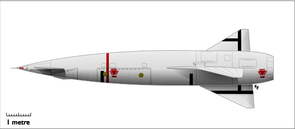Avro Blue Steel
| Blue steel | |
|---|---|
| General Information | |
| Type | Air-to-surface missile (nuclear) |
| Manufacturer | Avro |
| development | 1954 |
| Technical specifications | |
| length | 10,700 mm (35 ft ) |
| diameter | 701 mm (28 in ) |
| Combat weight | 7,270 kg (16,000 lb ) |
| span | 4000 mm (13 ft) |
| Drive First stage Second stage |
Liquid rocket engine. Liquid rocket engine. Liquid rocket engine |
| speed | Do 3 |
| Range | 240 km (150 miles ) |
| Furnishing | |
| Target location | Inertial navigation |
| Warhead | W28 nuclear warhead with 1.1 MT |
| Weapon platforms | Avro 698 Vulcan , Handley Page HP80 Victor |
| Lists on the subject | |
Blue Steel was a British air-to-surface missile that was used as a carrier for a thermonuclear warhead during the Cold War . It was used exclusively by the Avro 698 Vulcan and Handley Page HP80 Victor strategic bombers .
The development of the weapon went back to a government memorandum from 1954. It stated that Soviet anti-aircraft defenses would likely be able to seriously endanger the British V-bomber fleet as early as 1960 . One problem with the development was that the designers had no information about the size and nature of the warhead during the planning phase, as the first British hydrogen bomb was not completed until 1957.
The weapon was the size of a small fighter plane and had delta wings with canard slats. A mixture of hydrogen peroxide and kerosene was used as fuel . The refueling process took almost half an hour and was very dangerous. A 1.1-MT thermonuclear bomb W-28 "Red Snow" was used as a warhead.
After the weapon had been launched, which could be carried out at any operating height of the bomber from treetop height to 22,000 m, the rocket accelerated with its marching engine to a speed of Mach 1.5. During this phase she was also able to fly evasive maneuvers. In the actual target area, the second stage was ignited, which accelerated the missile to a speed of Mach 3.
Blue Steel was accepted into the troop service in 1963, although the disadvantages of the weapon, in particular the short range, had long been known. Even before the launch, the procurement of a successor, the Blue Steel Mark 2, was planned, which would replace the rocket engine with a ramjet engine in order to increase the range. But this plan was just as quickly dropped.
As an alternative, there was the option of buying the US AGM-48 Skybolt, which is currently under development . This project was discontinued by the Americans after several failures in 1962.
The Blue Steel was officially decommissioned on December 21, 1969.
Their role took over the Polaris missiles to the Royal Navy , on nuclear submarines of the Resolution-class submarine stationed.
